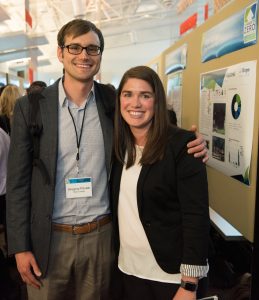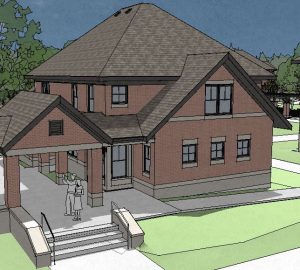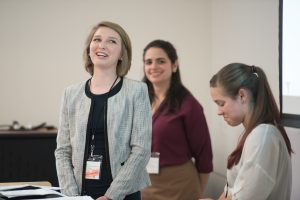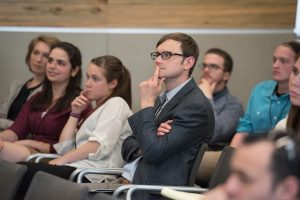
If they could have projected their 10-year-old futures after graduating from Hope, Rachel Bakken ’09 Romero and Greg Pavlak ’09 may have never seen another opportunity to work together again. Yet, maybe their engineering minds could have forecasted the possibility, albeit a small one. They did, after all, both graduate as mechanical engineering majors the same year, after taking multiple classes together on the same course sequence. They both had the same interest in building science, and they both ended up at the same graduate school, too — University of Colorado-Boulder — for a period of time to earn graduate degrees in the subject (Romero with a master’s; Pavlak with a doctorate).
So this past April, when they had the chance to work together again, though briefly, it was to culminate another engineering project for the sake of Hope students and energy efficient construction. Romero, as an energy engineer at the National Renewable Energy Laboratory (NREL) in Golden, Colorado, was helping to direct the Race to Zero Student Design Competition, a program sponsored by the U.S. Department of Energy that challenges collegiate students to design zero energy ready homes. Pavlak, as a visiting assistant professor of engineering at Hope, was mentoring three Hope engineering majors in their year-long senior design project for that competition.
Together, two alums and three soon-to-be alums, were making known the quality of Hope’s engineering program on a national stage. Of the 50 institutions that submitted designs to the Race to Zero competition, 40 were chosen while 39 teams traveled to Golden to vie for the title. Of those 39, the Hope team was the only one from a liberal arts, undergraduate institution. Baylie Mooney, Rachel Barbutti and Tiffany Oken — all members of the Hope engineering class of 2017 — put their quality work up against other teams from the University of Vermont, Syracuse University, Vanderbilt, and Purdue, Pavlak says, and learned a great deal about building science and themselves in the process.
“Dr. Roger Veldman called it a David and Goliath story. And it was. But even to be participating and competing against those other teams that had much more experience, specialized education, and funding was a testament to the hard work that our students put in to work out their design problems.”
“Some of the other teams they (Mooney, Barbutti, and Oken) were up against had these small armies of master’s and PhD engineers,” explains Pavlak. “(Hope engineering colleague) Roger Veldman called it a David and Goliath story. And it was. But even to be participating and competing against those other teams that had much more experience, specialized education, and funding, was a testament to the hard work that our students put in to work out their design problems.”

So, what was the Hope team’s project? Finding ways for the newest Hope housing project — Cook Village, currently under construction — to become so energy efficient that the building’s own renewable power can offset most or all its annual energy consumption. “We selected a Hope campus project partly because it was interesting and partly because of the timing,” Pavlak says. “Construction was starting on the next two buildings of the village last fall, and AMDG Architects, who did the original design, was still involved so we were able to work with them and get the detailed plans for these new buildings. We really approached it from the perspective of what can we do with this existing design to make it ready to meet the zero energy requirements for the competition. ”
Using energy modeling software to simulate, test, and derive proposed outcomes, Mooney, Barbutti, and Oken found they could take a Cook building from its base of 40% to 83% more efficient than the average home. To get there, they boosted insulation and mechanical systems quality, used strategic solar paneling, and took advantage of the relatively constant temp of the earth (roughly 50 degrees all year) to heat and cool the house with an enhanced geothermal system.

A skeptic might think that all of those energy upgrades might come at too high cost. But Mooney will be quick to tell them that it’s all not as expensive as they’d think. Especially considering the cost of energy consumption over the life of the eight-occupant, two-story home.
If they aren’t sustainability buzzwords already, “doable efficiency” just got elevated in the Hope engineering lexicon.
“We found through our updates that there was only a 2.7% pricing increase from the original bids for that building to the more energy efficient upgraded materials and systems we proposed,” says Mooney who hopes to go into building science for her career. “Considering that there was only a 2.7% cost increase, that was pretty impressive especially since we got so close to zero energy for a good size home (2800 square feet). It’s very exciting because significantly lowering energy use and cost for these already efficient (Cook Village) buildings seems doable.”

If they aren’t sustainability buzzwords already, “doable efficiency” just got elevated in the Hope engineering lexicon. Though the Hope team’s findings could not change energy efficiency for these recently completed buildings, future Cook Village buildings could use some of their recommendations. Either way, from Mooney’s perspective, everything about racing to zero was worth it. “The project, the competition and the trip out to Colorado — they were the highlight of my career at Hope,” she says.
“To have Hope playing on that level was a great way to get recognition for a strong program that is growing these really unique individuals who are well-rounded and well-educated. They don’t just speak engineering. They can literally speak Spanish, or they traveled abroad, or they play a sport. They are engineers with a liberal arts background, which of course I believe in.”
As for Romero, she was excited to have the opportunity to engage with and showcase Hope College students and faculty, especially one who was a former classmate, on her home turf of NREL where she has worked for seven years. And though Pavlak has recently taken a new position at Penn State and will be leaving Hope this summer, Romero hopes a Hope team will return to Race to Zero in the future.
“It was great to have others at NREL and in the competition know about Hope,” Romero explains. “To have Hope playing on that level was a great way to get recognition for a strong program that is growing these really unique individuals who are well-rounded and well-educated. They don’t just speak engineering. They can literally speak Spanish, or they traveled abroad, or they play a sport. They are engineers with a liberal arts background, which of course I believe in. Overall, I think the Hope team did a great job showing off the quality of Hope engineering.”


You go girl bailey